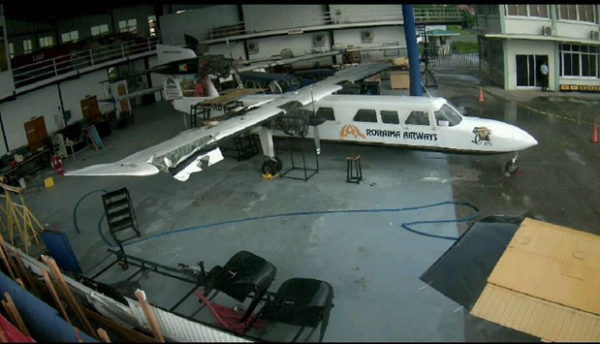The minor explosion on a Roraima Airways plane in June, which resulted in injury to a maintenance engineer could have been avoided if a risk assessment had been conducted before repairs started, the Department of Labour has found.
Around 2.05 pm on June 21, service and maintenance works were being carried out on a Britten Norman Trislander aircraft in the Roraima Airways hangar at the Eugene F Correia International Airport under the supervision of Aircraft Maintenance Engineer Anil Ramprashad when a fire erupted under the left wing. Ramprashad, who was in the vicinity, sustained burns and minor injuries to his feet after he jumped from the wing.

As a consequence, an investigation was undertaken by Senior Labour, Occupational Safety and Health Officer in the Ministry of Social Protection Prandatt Basdeo. The report, which was yesterday handed over by acting Chief Labour Officer Lydia Greene to a Roraima Airways representative, concluded that the accident could have been avoided.
Basdeo found that since Ramprashad was supervising the execution of the maintenance procedure, it would have been his responsibility to ensure that a risk assessment was done prior to starting the task.
The investigation found that the explosion in the aircraft wing may have been caused by aviation fuel vapours and exposed wires that could have arched when the engine was turned on. “After all,” the report said, “he was quite aware of the volatility of aviation fuel and the associating vapour which may have emanated from the pumps and ought to have taken ultimate care to ensure that an accident in which such fuel or vapour was an ingredient was not probable.”
The report went on to explain that while the employees did an excellent job in putting out the fire, the absence of an emergency medical evacuation vehicle at the airport was a cause of concern. Ramprashad had to be taken to the hospital “in his own car – a private vehicle – driven by a colleague at the risk of sustaining further injury,” the report added.
It also pointed out that while there is an Occupational Safety and Health (OSH) Committee in place, it is not properly constituted nor are the minutes submitted to the Ministry of Social Protection in conformity with the established procedures. “An examination of those minutes may have helped the ministry to determine whether or not there was a need to modify or amend the operations of the committee in the interest of safety in the company,” the report said.
In light of this, it was recommended that the company set up an OSH Committee according to the standards and procedures.
The investigation also found that while the company provides a limited amount of Personal Protection Equipment (PPE) of a general nature to its staff, specialised PPE suitable for use in the aircraft industry should be acquired and issued to all workers.
It also suggested that risk assessment be conducted prior to the beginning of all maintenance exercises and that an emergency medical response vehicle, such as an ambulance, be permanently established at the airport. “In fact, it may not be unreasonable to suggest that a complete medical emergency outfit should be set up at the airport,” the report said.
On the day of the accident, the maintenance was being carried out by Ramprashad along with Aircraft Technician Darcy Chambers. Other Roraima Airways employees, who were in the vicinity, were also interviewed during the course of the investigation, along with the company’s CEO, Gerry Gouveia, among others.





